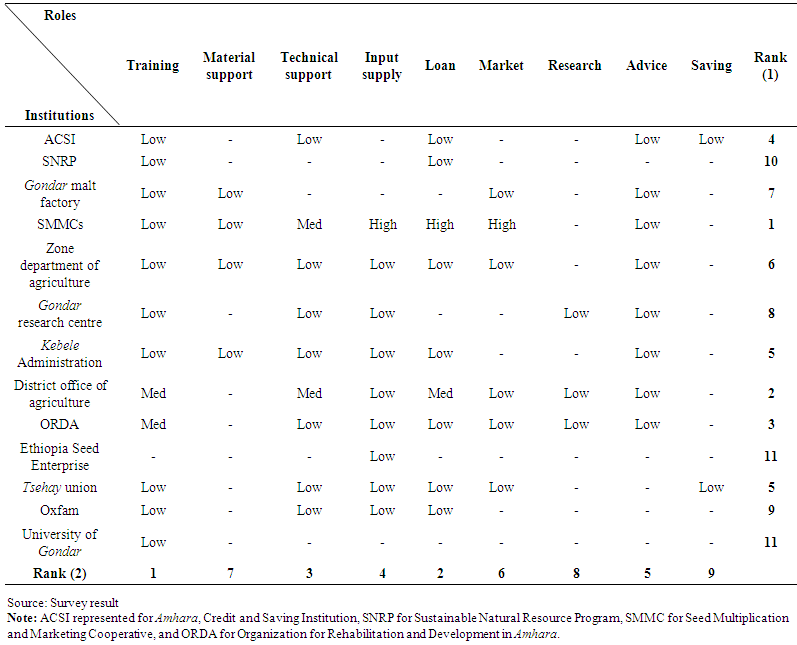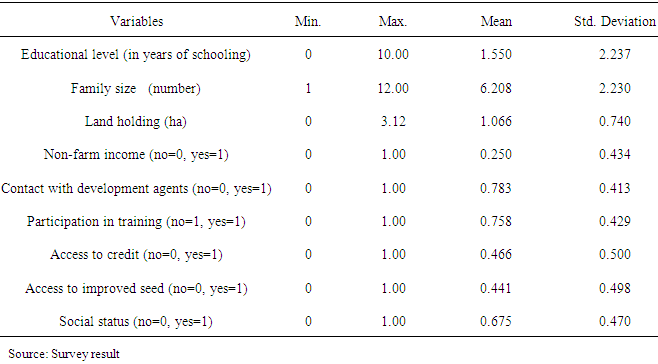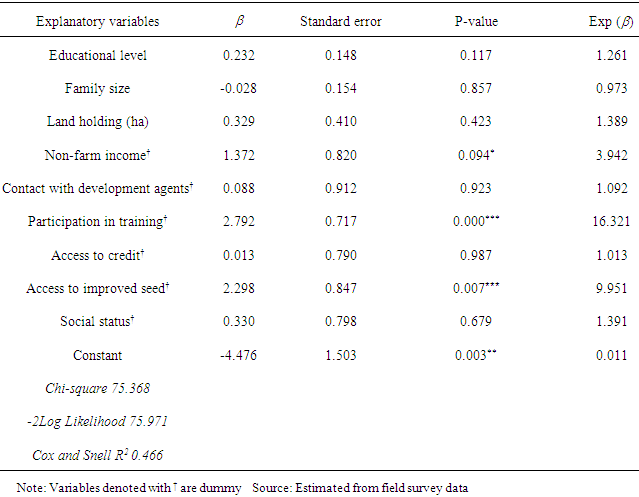-
Paper Information
- Next Paper
- Paper Submission
-
Journal Information
- About This Journal
- Editorial Board
- Current Issue
- Archive
- Author Guidelines
- Contact Us
International Journal of Agriculture and Forestry
p-ISSN: 2165-882X e-ISSN: 2165-8846
2017; 7(1): 7-12
doi:10.5923/j.ijaf.20170701.02

The Roles of Institutions for Malt-Barley Production in Smallholder Farming System: The Case of Wegera District, Northwest Ethiopia
Wuletaw M. Kebede1, Abebe D. Koye2, Essa C. Mussa2, Daniel T. Kebede3
1Department of Rural Development and Agricultural Extension, University of Gondar, Gondar, Ethiopia
2Department of Agricultural Economics, University of Gondar, Gondar, Ethiopia
3Department of Plant Sciences, University of Gondar, Gondar, Ethiopia
Correspondence to: Wuletaw M. Kebede, Department of Rural Development and Agricultural Extension, University of Gondar, Gondar, Ethiopia.
| Email: |  |
Copyright © 2017 Scientific & Academic Publishing. All Rights Reserved.
This work is licensed under the Creative Commons Attribution International License (CC BY).
http://creativecommons.org/licenses/by/4.0/

This study was conducted to examine the roles of institutions for malt-barely production by farmers in Wegera district of North Gondar, Ethiopia. A structured interview schedule was used to interview 120 farmers selected from two Kebeles through systematic random sampling method and focused group discussions to describe results. The collected data were analyzed using descriptive tools such as percentage, mean and standard deviation. Binary Logistic regression model was used to examine factors that determine the use of malt-barley technology. Results from the study showed that the roles of different institutions facilitated in access to new malt-barely seeds. Training and access to improved seed varieties are the main factors that had positive effects on the probability of participating in malt-barley production. To improve the roles of institutions in malt-barley production, the study suggested integrated seed system, efficient institutional linkage, effective extension service and skill training.
Keywords: Institutional linkage, Marketing, Seed multiplication, Malt-Barley
Cite this paper: Wuletaw M. Kebede, Abebe D. Koye, Essa C. Mussa, Daniel T. Kebede, The Roles of Institutions for Malt-Barley Production in Smallholder Farming System: The Case of Wegera District, Northwest Ethiopia, International Journal of Agriculture and Forestry, Vol. 7 No. 1, 2017, pp. 7-12. doi: 10.5923/j.ijaf.20170701.02.
Article Outline
1. Introduction
- Quality seeds, improved crop varieties and other agricultural inputs are essentials for sustainable agriculture to transform subsistence farming into a profit-making commodity. In Ethiopia, seed producers have supplied about a total of 1932.1tons of seeds to farmers that covered 77,080 ha of land in 2009 to 2013 [1]. However, this amount was insignificant for about 14 million smallholders [2] who couldn’t access to improved seeds adequately. Although research institutes are continuously developing new crop varieties, improved seeds sometimes do not reach farmers at all, or if they do, they get to them late. Thus, one of the major causes of low malt-barley productivity (1.3 t/ha) in Ethiopia is insufficient use of improved seed varieties [3]. Thus, farmers have been producing their own seeds so that local seed exchange is a common practice at least to increase productivity. Despite local seeds are characterized by low yields, lack of guaranteed seed quality, mix up of seed varieties and loss of desirable traits, farmers continue to use more local seeds and limited quantities of improved seeds [3].In Ethiopia, barley (Hordem Vulgare) is one of the first domesticated cereals, most staple and subsistence crop cultivated in more than one million ha with a total annual production of 1.78 million tons [2, 4]. It is the fourth cereal crop in terms of area planted after sorghum, maize, and wheat [2]. In addition to food barley, producing of malt-barley (Hordeum distichon L.) has a private benefit and societal profit [5]. The country has suitable agro-ecological situations to produce malt-barley. However, due to low level of production, the country has spending over 120 million birr to import malt every year. Although Arsi and Bale represent a significant barley producing areas [6], their supply of raw materials alone couldn’t able to keep with the increasing demands of domestic industries [3]. In Ethiopia, beer ‘alcohol’ production has increased from one million hectoliters to about four million hectoliters in 2003 to 2011 while the total demand for malt-barley in 2012/13 was about 72,000 tons; of which 35% was supplied from local farms [7]. Although the first advance made in identifying barley varieties of good malting quality since the 1970s, the Ethiopian Seed Enterprise has not sufficiently emphasized for seed multiplication and distribution of improved barley varieties [3]. Lack of improved barley seed uptake does not only affect farmers and consumers. It also affects seed producers as a means of financial losses for private producers and job losses as well. Malting varieties were tested in 2004 at country level. Adaptation, demonstration, and promotion of malt-barley were conducted widely in the six malt-barley producing districts (Janamora, Wegera, Debark, Dabat, Gondar Zuria, and Lay Armachiho) of North Gondar in 2005. Since 2006, the crop has been produced at farm level in those districts. Thus, the intension of this paper is to assess the roles of institutions and examining factors that affect malt-barley production at smallholder level of the two Kebeles in Wegera district.
2. Methodology
- This study was conducted in Wegera district of Northwest Ethiopia where farmers have been engaged in malt-barley production. Wegera is the sixth top barley producer district in Ethiopia [6]. Primary data were collected through household survey and focused group discussions conducted in the Dabir Lideta and Isak Dabir Kebeles of Wegera district in North Gondar. The study district and the two Kebeles were selected purposively due to the fact that their high production potential of malt-barely in terms of area coverage, agro-ecology and participation of farmers. After preliminary survey through direct observation, descriptive data on the socio-economic situations of farmers, the roles that development actors have played, general attributes of farmers involved in malt-barley production and obstacles of the seed system were captured using focused group discussions. Three focused group discussions were employed in Dabir Lideta and two in Isak Dabir Kebeles. Discussants were farmers who were participated in malt-barley production. A check list consisting of directing questions was used to facilitate the discussions. Initiatives to participate in malt-barley seed production, reasons of discontinuity by some farmers in the production system, and challenges of seed production were some of the most important discussion topics.Household survey was carried out for those smallholders who were selected through systematic random sampling in probability proportional to size in the two Kebeles from the list of the study population. A structured interview schedule was used to collect institutional, socio-economic, and bio-physical characteristics of households that enable to identify roles of institutions and factors whether that impedes farmers’ participation or not in the malt-barley seed production. The study covered 120 households (57 in Dabir Lideta and 63 in Dabir Esak Kebeles). An interview schedule was administered for household heads. The collected data, mainly from primary sources, were processed using SPSS (version 16) software for analysis. Secondary data obtained from agricultural offices were also included in the analysis and described qualitatively. After computing the descriptive statistics, a binary Logistic regression was used [8] to identify factors of land allocation to improved malt-barley seed production where the dependent variable has binary outcome (Y=1, if a household allocate most of its land to malt-barley seed production, 0 otherwise).
3. Results
3.1. Malt-Barely Production
- Barley is thought to have originated in the Fertile Crescent area of the Near East from the wild progenitor Hordeum spontaneum. It is one of the first cereals to have been domesticated [3]. The knowledge of seed production was, therefore, started ten thousand years ago at a juncture of foraging to farming in South East Asia. Millet and sorghum were the first domesticated crops in Africa and soon after other crops have been cultivated and diffused through trade and migration in other countries of the continent [9]. In Ethiopia, barley has ever been cultivated since 3000 BC [3]. But malt-barely was replicated with the establishment of modern malting in 1974 of St. George brewery and Asela malt factory in Ethiopia [5, 10]. Field based evidence shows that malt-barley seeds were introduced to the study area in 2005. Following seed technology generation, demonstrations were implemented on some varieties, namely Beka, Holker, HB-52, HB-120, HB-1533 and Miskal. These varieties were released in 1984 at national level. As a result, in 2005, Holker was prioritized and promoted in the study areas owing to its better productivity and adaptability qualities than other malt-barley varieties [11]. The collected data covered for seven consecutive production periods, between 2006/07 and 2012/13. Among 120 randomly selected farmers, 81 (67.5%) of them were either discontinued or did not produce malt-barley seed at all. The remaining 39 (32.5%) farmers were participated in malt-barley seed production in different production periods. Among 39 participant farmers, 12 (30.8%) of them have been participated throughout the whole seven years, 2(5.1%) for six years, 6 (15.3%) for five years, 7(18.0%) for four years, and the remaining 12(30.8%) farmers have been participated for three consecutive years since 2010/11. Every year, all farmers have been encouraged to produce malt-barley as long as he/she has a piece of land for cultivation. However, farmers’ discontinuance and market problems were the two main obstacles of malt-barley seed production identified during focused group discussions. Among 81 farmers, 13 (16%) of them have discontinued after they produced for one and two years due to several reasons such as delay in input delivery, high interest rate of credit services, lack of money to purchase improved seeds, and low selling price for their produce. According to the discussion result, market related problems prevailed than any other limitations. For one reason, there was no clear contractual modality to which they can sale their output. Secondly, seed multiplication and marketing cooperative was not well organized in financial and human capacity that unable to compute with other seed companies. Key informant interviews have similar explanations and there was also the question of seed quality problems caused by noxious weeds and follow up problems. Some of the farmers also have preferred to produce other crops such as wheat and food barley varieties. Nevertheless, this result cannot give reliable clues on the profitability of producing seeds be it wheat, food-barley or malt-barley. It needs further study on the comparative advantage of malt-barely versus other potential cereal crops.
3.2. Seed Multiplication and Marketing
- Seed multiplication: The objectives of seed multiplication involved some mechanisms through which farmers produce quality seed for themselves and to produce more seeds so that they can sell through cooperative at some marginal profit. It enables to establish sustainable seed supply systems. One of the aims of the government was to improve farmers’ knowledge in seed multiplication through the efforts of extension agents, agricultural experts, cooperatives, unions, development projects, industries, researchers, academia and officials. However, the objective was not achieved as it was expected. The survey result indicates that lack of seed certification process attributed to low productivity and less quality for the malt-barley seed production.
|
|
 | Table 3. Roles of Institutions |
3.3. Roles of Institutions in Malt-barley Seed Production
- Crop production has its own process from the very beginning of seed generation to adoption. Seed system is largely influenced by the roles of institutions. There are several institutions involved in the malt-barley seed system. However, access to improved seed had some limitations based on discussions and the survey results. First, gaps and overlaps in responsibilities and duplication efforts of various institutions resulted in wastage of resources. Second, actors of various institutions implemented a range of activities were not coordinated and integrated. Roles of institutions they played in terms of activities are presented on the following Table. SMMCs, District office of agriculture, ORDA, and ACSI are the first institutional category on the above linkage matrix of “Rank 2”. The survey result indicates that these are the key institutions contributed for various activities in malt-barley seed production. Kebele administration, Thehay union, zone department of agriculture, malt factory, and research center are secondary institutions involved in the same activities while Oxfam, SNRP, seed enterprise and University of Gondar are tertiary institutions /programs that played least efforts towards the seed system. If these institutions were actively engaged in the production system, apparent outcomes would have been observed like Mekelle University that has developed and released three high yielding barley varieties for farmers working with local communities [1].Roles of institutions are listed horizontally on the above table. Nine key roles were identified for analysis and all institutions delivered trainings related to malt-barley technology followed by loan provisions and different technical supports. It shows that efforts were made towards training related to malt-barley technology. Access to inputs such as fertilizer, improved seed and chemicals; access to information trough extension service, and marketing services were delivered in different levels subsequently in medium condition. Material support such as office equipments for cooperative, training handouts, guidelines; research and saving were delivered but in limited supports from those concerned institutions. Taken together, limitations were lack of follow up, low monitoring and evaluation mechanisms, inefficient marketing systems, and limited technical and financial supports.
4. Discussion
- This study indicates that when the seed system is immature, various institutions working for the well being of farmers can play a great role in many ways: Strengthening seed multiplication, dissemination through formal /informal exchange and marketing cooperative, access to information for agronomic practices, marketing services, and selective training to farmers are found to be instrumental in increasing farmers knowledge how to bargain with seed dealers and increase productivity for the achievement of sustainable production. Quality seed production is the most important aspect in increasing yield and thereby household income. Logistic regression model was employed to test whether a particular farmer engage him/her self in improved seed production and identifying challenges in production process that enables to restrain using different coping and mitigating mechanisms. The result shows that access to improved seed and trainings encouraged households to allocate more farm land to malt-barley technology for those participants. Non-farm incomes also have little contribution for smallholders. In addition, the results also reveal that not only seed multiplication but also seed marketing was another constraint for those farmers who were able to produce more seed for market. Marketing information is required either in access to quality seed or to sell their output. Contractual procedures and paralegal services are important considerations for farmers. There is a need to establish institutional linkage frameworks through which farmers can access technical and management related services, one of which sustainable seed multiplication and marketing system through their own cooperative. Another important constraint that impedes seed quality was the noxious weed locally farmers call it ‘Boren’. Lack of due consideration given by agricultural professionals, researchers and academia how to tackle the weed infestation resulted in less quality and low yield seed production.
5. Conclusions
- Malt-barely seed production is undergoing in the study areas. However, constraints such as duplication efforts, low institutional linkages, and imperfect marketing mechanisms undermine the production potentials of market oriented commodities in general malt-barley in particular. Although trainings show a positive and significant influence on land allocated to malt-barley production, many smallholders were challenged with production and marketing issues. The findings imply that in order to produce quality seed and compete in marketing systems, institutions not only give emphasis on trainings but also they should pay attention to: (1) timely advising, monitoring, and follow up, (2) skill trainings are required in not only when, how, and what to produce but also how to face marketing constraints, weed protection mechanisms and comparative advantages.The survey result shows that smallholders have a land size ranged from zero to 3.12 ha. Zero land size means a farmer who is landless but can use share cropping, land rent-in, informal markets or gifts from parents. Small sizes of agricultural plots lead to pressure over the land through competition of crop production and livestock husbandry. Land fragmentation and land degradation in the highland of Ethiopia undermines the possibility of creating sustainable malt-barley seed production system. Institutional linkage is an important implication to handle such constraints through multidisciplinary team works. The continuity of malt-barley production is challenged by institutional and technical limitations. Yet, access to improved seeds and trainings are the two most important aspects that encouraged producers to allocate more crop lands for malt-barley production. Thus, to be able to improve malt-barely production and to ensure the sustenance of seed businesses in Ethiopia, efforts must be made to step up the current low level of improved seed production in terms of quality and quantity by farmers and practitioners.
ACKNOWLEDGEMENTS
- The authors are grateful to smallholders and field staff who participated and cooperated in this research. The authors would like to also acknowledge reviewers for their useful comments. This paper has also been supported by a research grant from University of Gondar, Ethiopia.
Note
- 1. Farmers sold the malt-barley seed for Tsehay union and Dashen malt factory.
 Abstract
Abstract Reference
Reference Full-Text PDF
Full-Text PDF Full-text HTML
Full-text HTML
